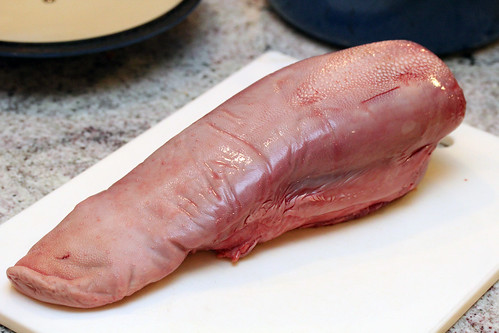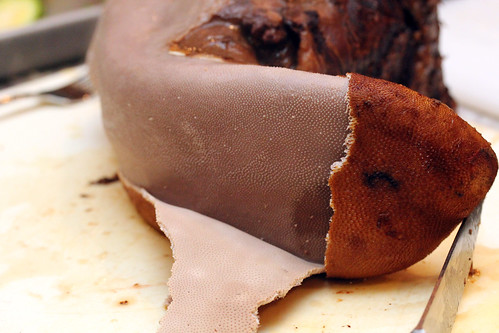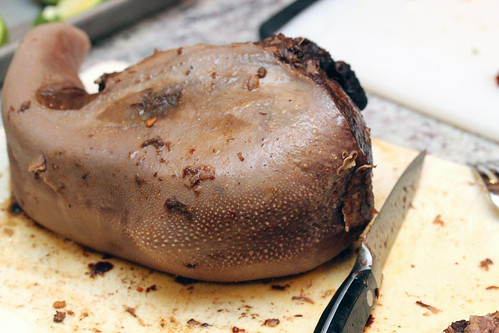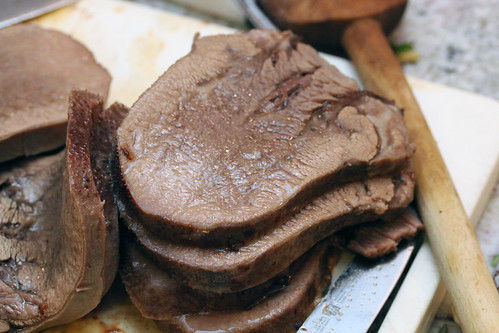
I'm happy to start this post with the above photo. That's a 4 lb cow tongue. You won't find that served in your average steak house. I first had cow tongue at Chris Cosentino's Incanto in San Francisco. It was a genius dish, served on top of a bed of arugula. The bitterness of the arugula played well with the meatiness of the tongue.
Well, how to re-create it? Mr. Cosentino's new book Beginnings
I've thrown this recipe together, tweaking the braise from Edible Seattle, and the salsa verde from Chef's Under Fire. The result is simple and delicious:
1 beef tongueThere must be a real run on beef tongue right now, as we paid $5/pound for this tongue. Right. So, combine all of the above ingredients into a heavy stock pot. Add enough water to cover the tongue, and simmer for three hours.
1 yellow onion cut in half
1 whole bulb of garlic cut in half
5 black peppercorns
2 dried ancho chiles
½ cup white wine vinegar
3 tablespoons salt

Make sure the tongue stays mostly submerged. Turn it periodically over the three hours of cooking.

The broth will darken, and the outer layers of the tongue will spice up. Meanwhile, prepare the salsa verde:
1 bunch parsleyCombine all the salsa verde ingredients in a food processor. Pulse into a light paste. Set aside in the fridge.
1 bunch cilantro
½ bunch fresh mint
4 cloves of garlic
1 tbsp capers
2 anchovies
¾ cup of extra-virgin olive oil
Black pepper
sea salt
juice of 2 limes
Also, prepare:
Sweet-sautéed onions
arugula
When it comes time, you'll dress the arugula in salsa verde, and place the caramelized onions on top.
Alright, here comes the fun part. At the end of three hours of cooking, fish the tongue out of the broth.

You're gonna have to peel that tongue while it's still hot. Tastebuds should be tasting, not tasted. Right, so keep the squeamish out of the kitchen for this next bit.

So, make a shallow incision in the outer layer of the tongue, and pull it off the tongue.

It actually comes off very easily. I think it's fascinating that you can see the shape of the tastebuds in the underlying muscle. Right.

Once you've cleaned off all the outer layer, wipe off the outside of the tongue.

Starting at the end of the tongue that was attached to the base of the mouth (that doesn't have any of that skin on it), slice the tongue into ¼ to ½ inch steaks.

Heat some oil in a pan over high heat. When the pan is screaming hot, sear the steaks on each side, to give them a nice caramelized cover. Place the salsa-dressed arugula on a plate. Set one to two steaks per serving onto the arugula, place some caramelized onion on top and a dollop of extra salsa verde on top.

Serve while hot. The bitterness of the arugula, the brightness of the salsa and the deep richness of the tongue comes across as a pretty amazing combination. Next time, I might reduce the braising broth into a sauce of its own, but for this time, dinner was enjoyed by three out of four dining companions. (Mrs. Dude was very polite).
Yum.
By Bbq Dude

4 comments:
Nice! I really like tongue. There is something about the texture that really appeals to me.
Is there a way to peel the tongue prior to braising? Or do the spices in the braise permiate through making that not matter?
Mike,
Thanks, it was pretty tasty.
FoodLion,
Not only do you have to cook it to peel it, apparently if you let it cool it can be very difficult to peel. You could definitely taste the seasoning in the peel (which we didn't serve), and in the end of the tongue that was attached to the mouth. It's not clear to me how much the seasoning mattered for the rest of the tongue.
Just "peel" the tongue with a knife before cooking. It takes a tad bit of skill but it reduces your cooking time quite a bit and you don't have to worry about unsheathing the tongue while it's still hot. Just make sure your knife is sharp.
Post a Comment